Welding Residual Stress Distributions in the Thickness Direction under Constraints Using Neutron Diffraction and Contour Methods
Abstract
:1. Introduction
2. Materials and Experimental Procedures
2.1. Material Preparation
2.2. Constrained Condition in Specimens
2.3. Welding Residual Stress Measurement Using the Cutting Method
2.4. Welding Residual Stress Measurement Using Neutron Diffraction
2.5. Welding Residual Stress Measurement Using the Contour Method
3. Results and Discussion
3.1. Welding Residual Stress Distribution in Specimens
3.2. Welding Residual Stress in Thickness Direction with Constraint Effect
3.3. Relationship between Constraint and Welding Residual Stress
4. Conclusions
Author Contributions
Funding
Institutional Review Board Statement
Informed Consent Statement
Acknowledgments
Conflicts of Interest
References
- Kim, D. Offshore Plant Industry. J. Korean Soc. Power Syst. Eng. 2013, 17, 12–16. [Google Scholar]
- Hong, S. Market Expansion and Response Strategies in the Offshore Structure; Korea Institute for Industrial Economics & Trade: Seoul, Republic of Korea, 2006; pp. 38–40. [Google Scholar]
- Seo, G.; Ju, H.; Park, S. Offshore plant industry development plan. J. Korean Soc. Mech. Eng. 2012, 52, 30–35. [Google Scholar]
- Yi, M.; Park, J. Study of Heat Source Model and Residual Stress Caused by Welding in GMAW of AI Alloy. Metals 2022, 12, 891. [Google Scholar] [CrossRef]
- Handbook of The Korean Welding and Joining Society; Construction of Inspection: Seoul, Republic of Korean, 2008; p. 2.
- Park, J. Mechanism and Effects of Welding Residual Stress Mechanism of Welding Residual Stress. J. KWS 2004, 22, 1–2. [Google Scholar]
- Kim, J.; Park, J.; Jin, T. Review on the International Joint Researches for Evaluation of Welding Residual Stresses. J. KWS 2005, 23, 8–17. [Google Scholar]
- Jin, H.; Lee, D.; Shin, S. Effect of Distance and Restraint Degree between Fillet and Butt Weldment on Residual Stress Redistribution at each Weldment. J. KWJS 2010, 28, 59–64. [Google Scholar]
- An, G.; Woo, W.; Park, J.; Em, V. Comparison of crack-arrest fracture toughness between low and high heat-input thick weld specimens. Int. J. Fract. 2015, 194, 197–203. [Google Scholar] [CrossRef]
- Withers, P.; Bhadeshia, H. Residual stress. Part 1—Measurement techniques. Mater. Sci. Techol. 2001, 17, 355–365. [Google Scholar] [CrossRef]
- Park, J.; An, G.; Ma, N.; Kim, S. Effect of Transverse Restraint on Welding Residual Stress in V-Groove Butt Welding. Metals 2022, 12, 654. [Google Scholar] [CrossRef]
- An, G.; Park, J.; Han, I. Effects of High Toughness and Welding Residual Stress for Unstable Fracture Prevention. Appl. Sci. 2020, 10, 8613. [Google Scholar] [CrossRef]
- An, G.; Park, J.; Han, I.; Woo, W. Unstable fracture phenomenon of welded joints with weld residual stresses. Theoretical and Applied Fracture Mechanics. 2020, 109, 1–8. [Google Scholar] [CrossRef]
- Wang, Y. Phases Stress Measurement of Centrifugally Cast Duplex Stainless Steel by Neutron Diffraction. Quantum Beam Sci. 2020, 4, 28. [Google Scholar] [CrossRef]
- Masaoka, I.; Yada, M.; Sasaki, R. Brittle Fracture Initiation Characteristics of Weld Joint for 80 kg/mm2 High Strength Thick Plate Steel(Report3)—Effect of Residual Stress and Repair Welding on Brittle Fracture Initiation from Surface Notch in Fusion Line of Welded Joints. J. Jpn. Weld. Soc. 2010, 44, 914–9230. [Google Scholar] [CrossRef] [PubMed] [Green Version]
- An, G.; Woo, W.; Park, J. Brittle crack-arrest fracture toughness in a high heat input thick steel weld. Int. J. Fract. 2014, 185, 179–185. [Google Scholar] [CrossRef]
- Bezensek, B.; Hancock, J. The toughness of laser welded joints in the ductile-brittle transition. Eng. Fract. Mech. 2007, 74, 2395–2419. [Google Scholar] [CrossRef]
- Park, J.; Lee, H.; Bang, H. Effects of mechanical constraints on angular distortion of welding joints. Sci. Technol. Weld. J. 2002, 7, 232–239. [Google Scholar] [CrossRef]
- Smith, D.; Bouchard, P.; George, D. Measurement and prediction of residual stresses in thick-section steel welds. J. Strain Anal. 2000, 35, 287–305. [Google Scholar] [CrossRef]
- Withers, P.; Turski, M.; Edwards, L.; Bouchard, P.; Buttle, D. Recent advances in residual stress measurement. Int. J. Pres. Ves. Pip. 2008, 85, 118–127. [Google Scholar] [CrossRef]
- Rossini, N.; Dassisti, M.; Benyounis, K.; Olabi, A. Methods of measuring residual stresses in components. Mater. Des. 2012, 35, 572–588. [Google Scholar] [CrossRef] [Green Version]
- Kim, I.; Jeong, S.; Choi, H.; Kim, M. Study on the Fracture Toughness of FCA Weldment with the Yield Strength 420MPa Grade High Strength Steels for Offshore Structures Depending on the Welding Position. JWJ 2018, 36, 67–73. [Google Scholar] [CrossRef] [Green Version]
- Yokura, T. Ship and Offshore Structure. JWS 2012, 81, 402–406. [Google Scholar] [CrossRef] [Green Version]
- Woo, W.; An, G.; Kingston, E.; DeWald, A.; Smith, D.; Hill, M. Through-thickness distributions of residual stresses in two extreme heat-input thick welds: A neutron diffraction, contour method and deep hole drilling study. Acta Mater. 2013, 61, 3564–3574. [Google Scholar] [CrossRef]
- Allen, A.; Hutchings, M.; Winsor, C.; Andreani, C. Neutron diffraction methods for the study of residual stress fields. Adv. Phys. 1985, 34, 445–473. [Google Scholar] [CrossRef]
- Hutchings, M.; Withers, P.; Holden, T.; Lorentzen, T. Introduction to the Characterization of Residual Stress by Neutron Diffraction; Taylor and Francis: London, UK, 2005; p. 420. [Google Scholar]
- Seong, B.; Em, V.; Mikula, P.; Saroun, J.; Kang, M. Optimization of a bent perfect Si(111) mono chromator at a small take-off angle for use in a stress instrument. J. Appl. Cryst. 2010, 43, 654–658. [Google Scholar] [CrossRef]
- Woo, W.; Em, V.; Seong, B.; Shin, E.; Mikula, P.; Joo, J.; Kang, M. Effect of wavelength-dependent attenuation on neutron diffraction stress measurements at depth in steels. J. Appl. Cryst. 2011, 44, 747–754. [Google Scholar] [CrossRef]
- Woo, W.; Em, V.; Seong, B.; Mikula, P.; An, G. Residual stress determination in a thick ferritic steel weld plate using neutron diffraction. J. Mater. Sci. 2012, 47, 5617–5623. [Google Scholar] [CrossRef]
- Prime, M. Cross-Sectional Mapping of Residual Stresses by Measuring the Surface Contour After a Cut. J. Eng. Mater. Tech. Trans. ASME 2001, 123, 162–168. [Google Scholar] [CrossRef] [Green Version]
- Kartal, M.; Liljedahl, C.; Gungor, S.; Edwards, L.; Fitzpatrick, M. Determination of the profile of the complete residual stress tensor in a VPPA weld using the multi-axial contour method. Acta Mater. 2008, 56, 4417–4428. [Google Scholar] [CrossRef]
- Zhang, Y.; Ganguly, S.; Edwards, L.; Fitzpatrick, M. Cross-sectional mapping of residual stresses in a VPPA weld using the contour method. Acta Meter. 2004, 52, 5225–5232. [Google Scholar] [CrossRef]
- Prime, M.; Gna¨upel-Herold, T.; Baumann, J.; Lederich, R.; Bowden, D.; Sebring, R. Residual stress measurements in a thick, dissimilar aluminum alloy friction stir weld. Acta Meter. 2006, 54, 4013–4021. [Google Scholar] [CrossRef]
- Sonne, M.; Carlone, P.; Hattel, H. Assessment of the Contour Method for 2-D Cross Sectional Residual Stress Measurements of Friction Stir Welded Parts of AA2024-T3-Numerical and Experimental Comparison. Metals 2017, 7, 508. [Google Scholar] [CrossRef] [Green Version]
- Pagliaro, P.; Prime, M.B.; Swenson, H.; Zuccarello, B. Measuring multiple residual-stress components using the contour method and multiple cuts. Exp. Mech. 2010, 50, 187–194. [Google Scholar] [CrossRef]
- Park, J.; An, G.; Woo, W.; Heo, S. Measurement of Welding Residual Stress in a 25-mm Thick Butt Joint using Inherent Strain Method. KWJS 2013, 31, 67–72. [Google Scholar]
- Cao, X.; Shen, S.; Wu, M.; Tao, Z.; Liu, S.; Tao, Q.; Kong, J.; Zhang, H.; Li, J.; Zhang, Y.; et al. Residual Stresses of 550 MPa high strength steel welded cruciform sections: Experimental and numerical study. Structures 2022, 44, 579–593. [Google Scholar] [CrossRef]


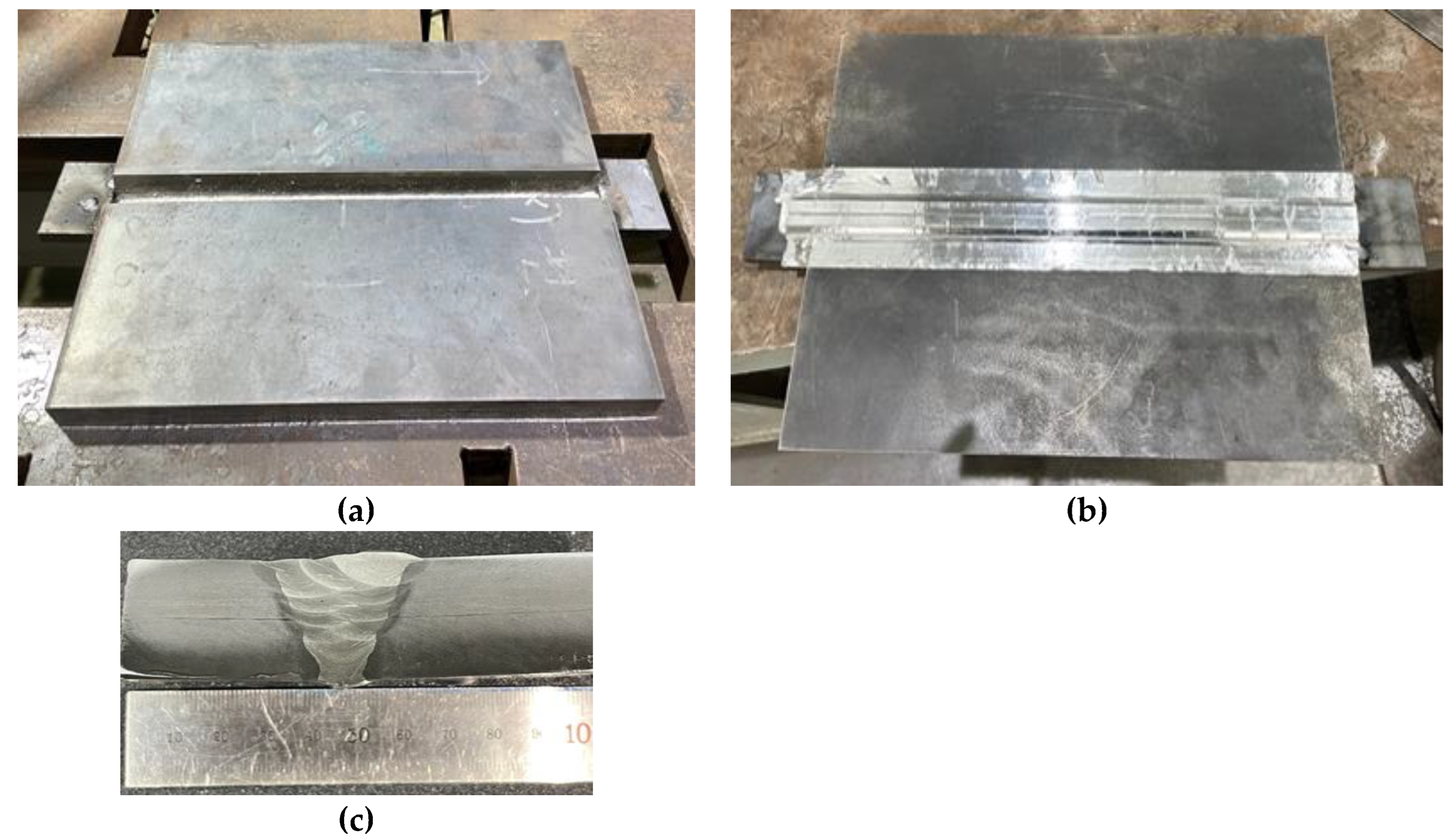
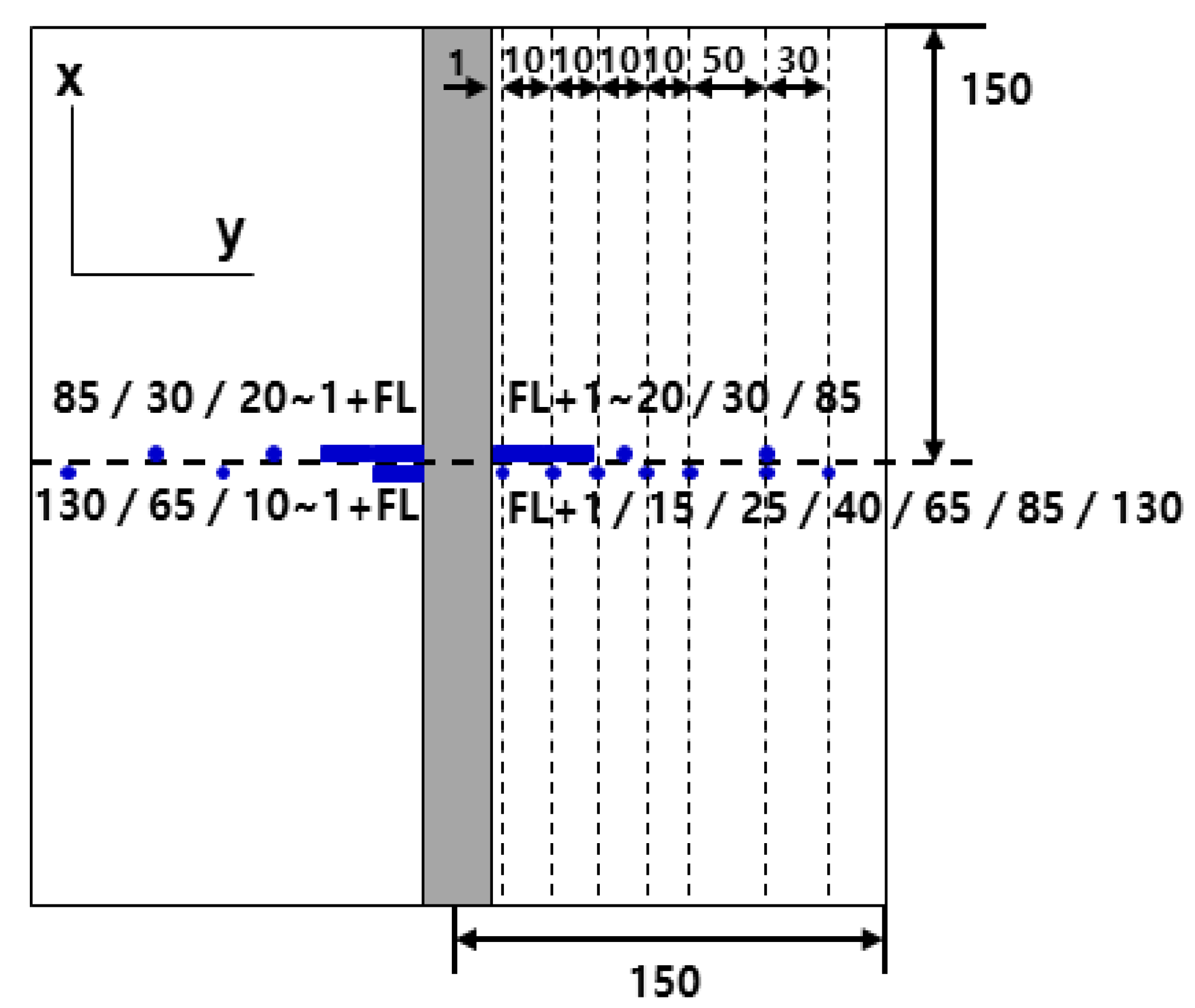
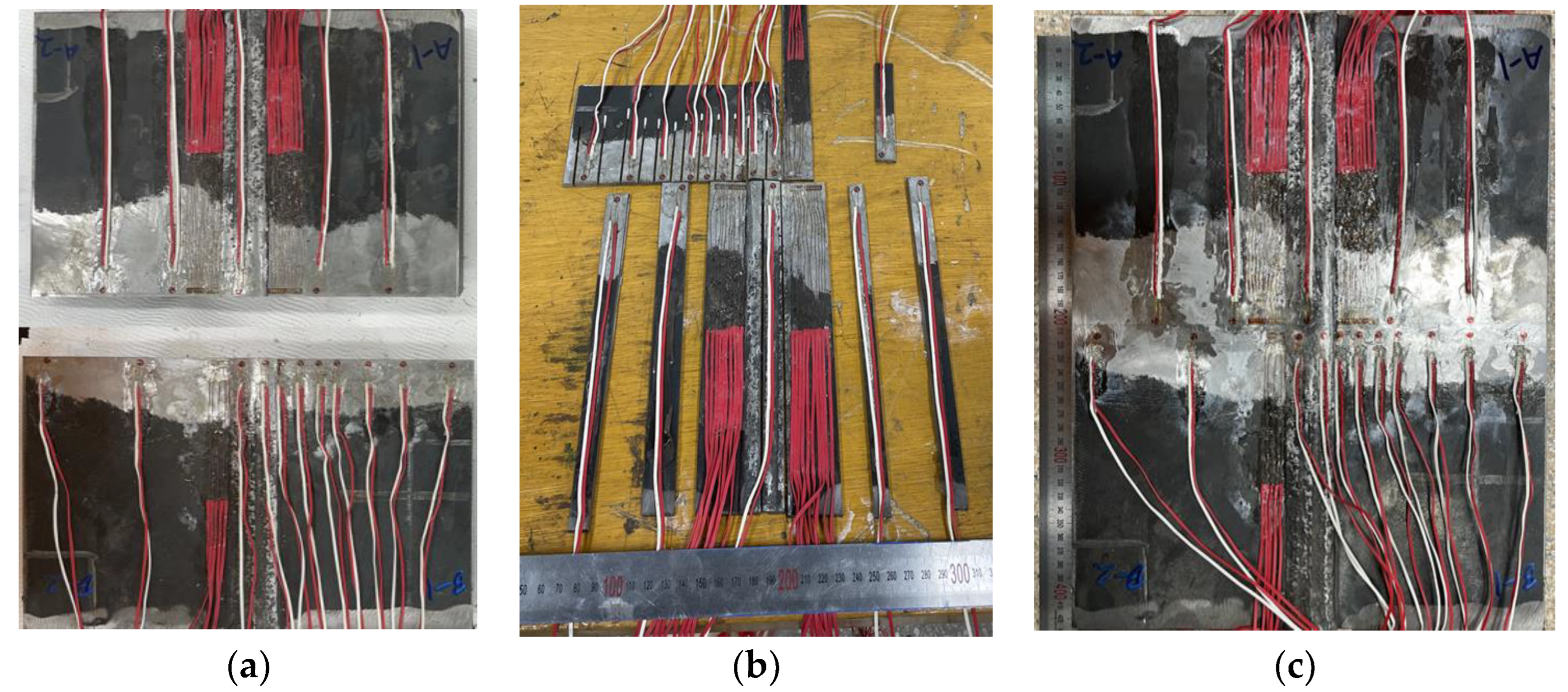
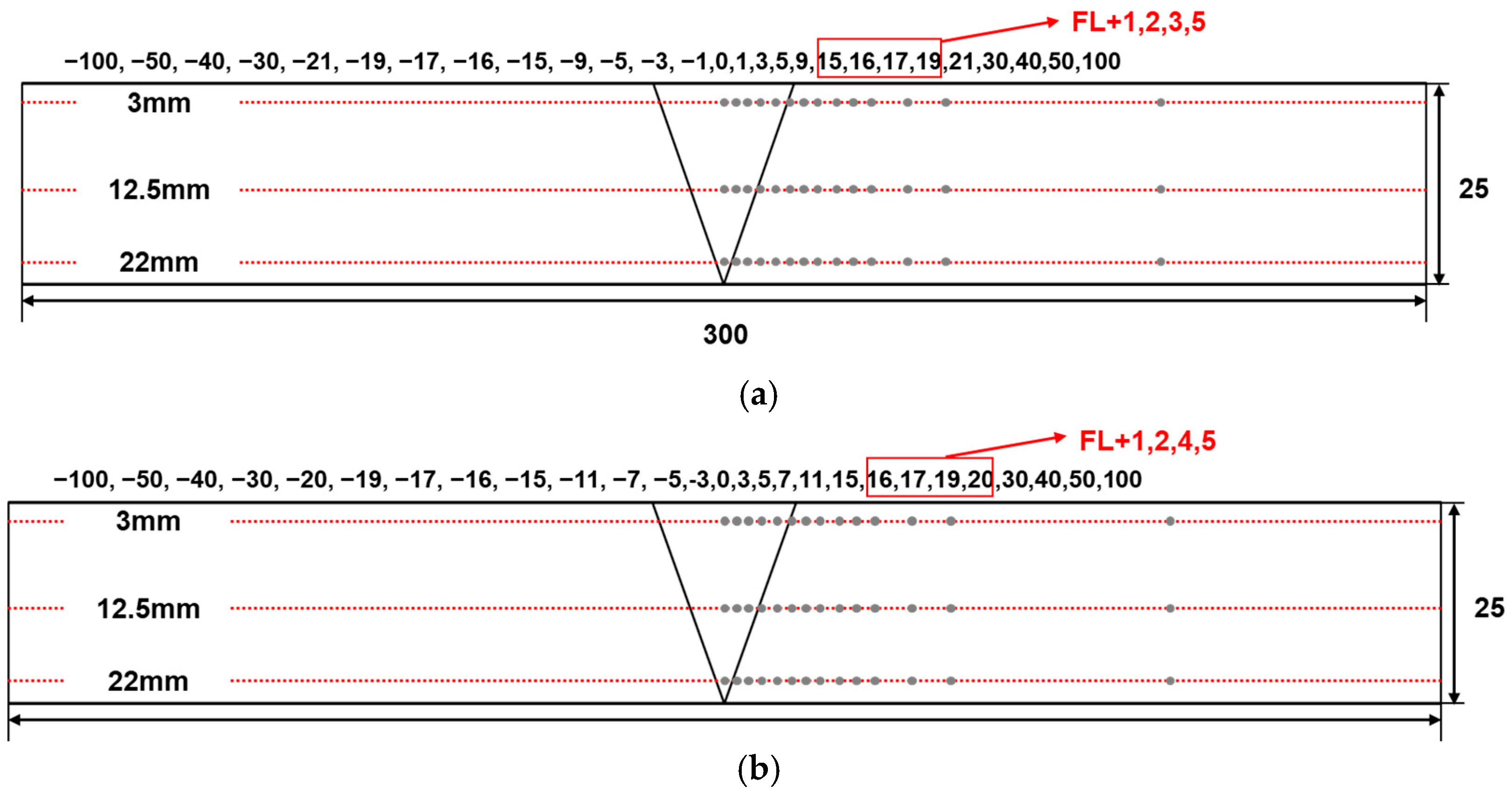




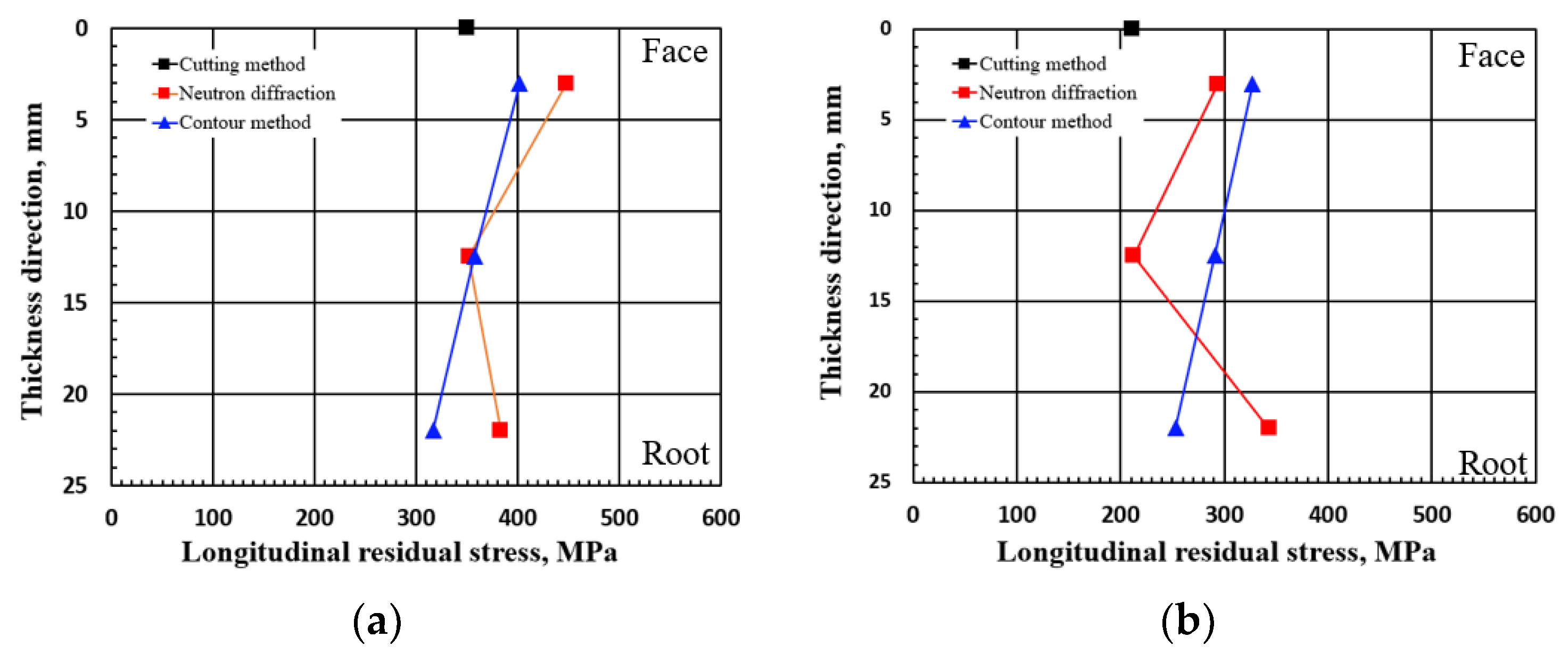
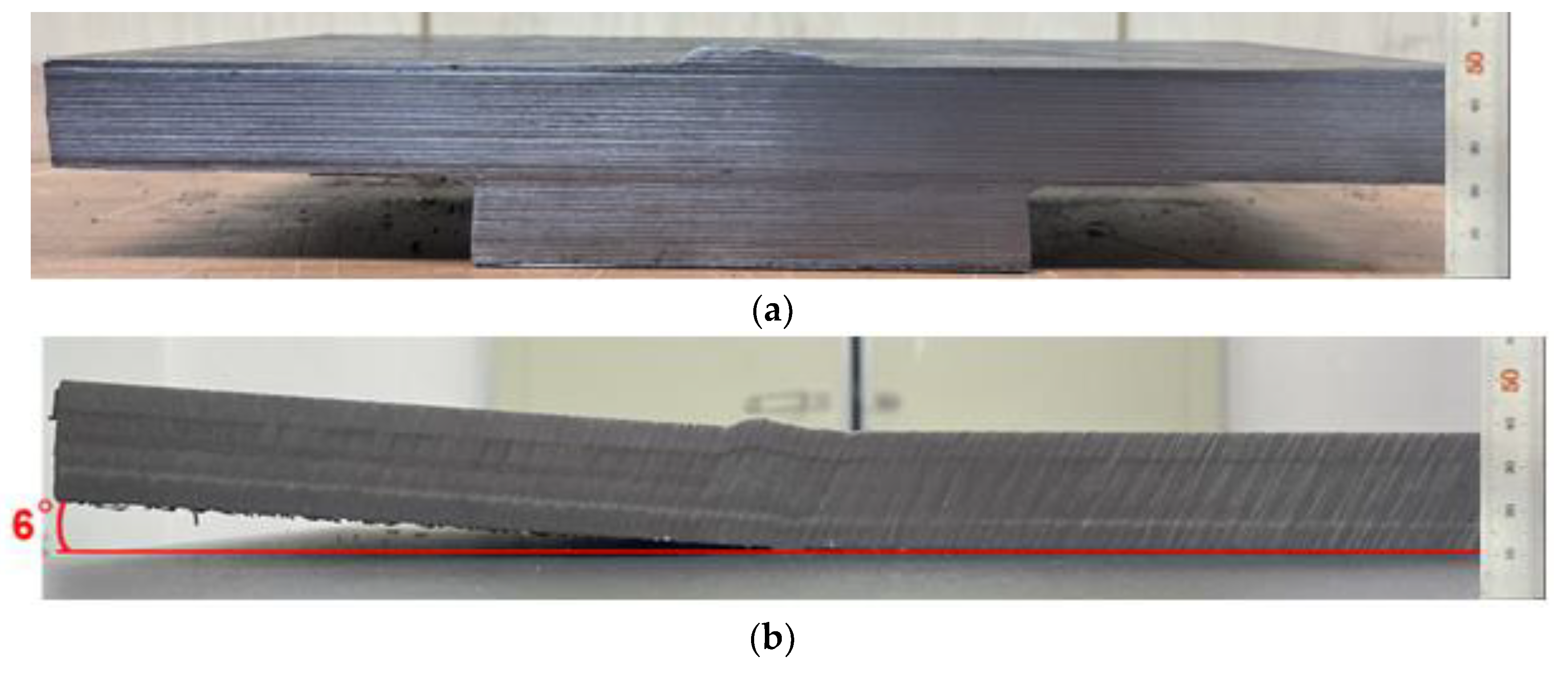
| Material | C | Si | Mn | P | S |
|---|---|---|---|---|---|
| E500 | ≥0.08 | ≥0.2 | ≥1.6 | ≥0.01 | ≥0.005 |
| Material | Yield Stress (MPa) | Tensile Stress (MPa) | Elongation (%) | Charpy Impact Test, −40 °C, (J) |
|---|---|---|---|---|
| E500 | 529 | 646 | 19 | 249 J |
| Welding Consumable | C | Si | Mn | P | S |
|---|---|---|---|---|---|
| AWS A5.29 E91T1 | 0.06 | 0.29 | 1.23 | 0.007 | 0.008 |
| Welding Consumable | Yield Stress (MPa) | Tensile Stress (MPa) | Elongation (%) |
|---|---|---|---|
| AWS A5.29 E91T1 | 580 | 650 | 20 |
| Process | Pass No. | Current (A) | Voltage (V) | Speed (cm/min) | Heat Input (KJ/cm) |
|---|---|---|---|---|---|
| FCAW * | 11 | 270 | 30 | 32 | 15 |
| Wire Electric Discharge Machining Conditions | |
|---|---|
| Wire component | Wire dimension |
| Brass (Cu 65% + Zn 35%) | 0.25 mm |
Disclaimer/Publisher’s Note: The statements, opinions and data contained in all publications are solely those of the individual author(s) and contributor(s) and not of MDPI and/or the editor(s). MDPI and/or the editor(s) disclaim responsibility for any injury to people or property resulting from any ideas, methods, instructions or products referred to in the content. |
© 2022 by the authors. Licensee MDPI, Basel, Switzerland. This article is an open access article distributed under the terms and conditions of the Creative Commons Attribution (CC BY) license (https://creativecommons.org/licenses/by/4.0/).
Share and Cite
Seong, D.; An, G.; Park, J.; Woo, W. Welding Residual Stress Distributions in the Thickness Direction under Constraints Using Neutron Diffraction and Contour Methods. Metals 2023, 13, 25. https://doi.org/10.3390/met13010025
Seong D, An G, Park J, Woo W. Welding Residual Stress Distributions in the Thickness Direction under Constraints Using Neutron Diffraction and Contour Methods. Metals. 2023; 13(1):25. https://doi.org/10.3390/met13010025
Chicago/Turabian StyleSeong, Daehee, Gyubaek An, Jeongung Park, and Wanchuck Woo. 2023. "Welding Residual Stress Distributions in the Thickness Direction under Constraints Using Neutron Diffraction and Contour Methods" Metals 13, no. 1: 25. https://doi.org/10.3390/met13010025





